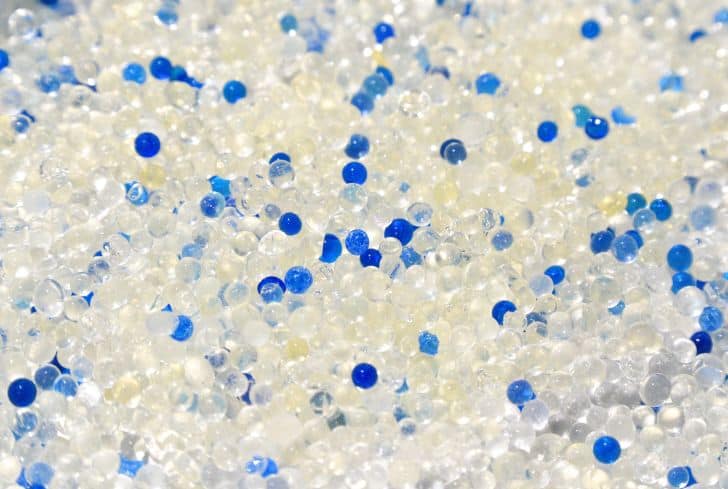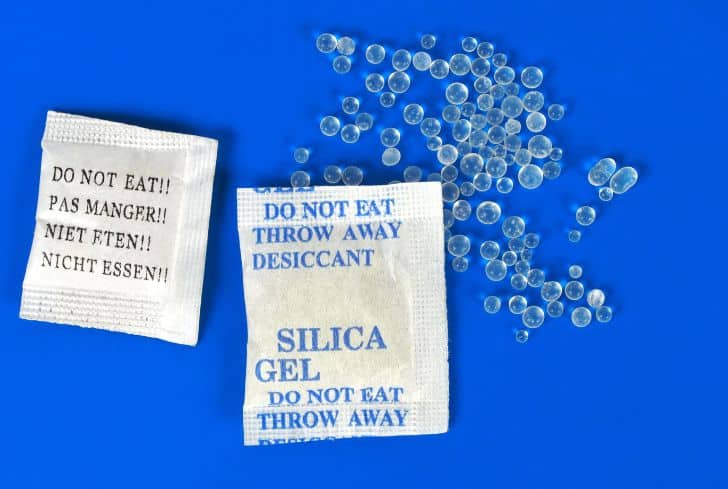Silica gel is growing in use cases every decade. It was discovered in the 1960s and has served many worldwide purposes since then. From being the filter for dangerous fumes in the first world war to one of its most pressing present-day uses as cat litter, silica gel has undoubtedly come a long way.
Silica gel uses a process called adsorption to “absorb” moisture; this is what makes it a desiccant. As cat litter, it can be used to separate humidity from pee and fecal matter, hence the clumping property.
It is clear that silica gel is a consumer’s favorite in many fields. So, what is the nature of its biodegradability? If the concern is with environmental awareness, we must also become aware of its effects on biodiversity and the ecosystem. Don’t stop reading to learn about the post-use impacts of silica gel!
Is Silica Gel Biodegradable?
Since silica gel is used in many everyday applications, it is a relief to know that it is biodegradable. However, biodegradability has a catch – it depends on where the waste ends. Silica gel absorbs moisture or humidity, so it is bad for good soil and the ocean and shouldn’t biodegrade there.
The properties of silica gel are astonishing. Each micro or macro ball is sized within 2.5nm to 7.0nm, which is very tiny considering their ability.
This is why it is popular in cat households in the US. It can absorb up to forty times its weight in water.
“Wet” silica gel swells up to a hundred times its weight; then, it stops absorbing. To cat owners, it is time to scoop and dump.
But dump where? Since silica gel is biodegradable, it would make sense to compost it or flush it sometimes, right?
No, you can’t do either, and we will tell you why.
Silica gel is a product of silicon dioxide. In its simplest terms, it is described as industrial sand. Sand in its purest or most modified form is still sand and does not biodegrade.
Of course, it will break down into smaller particles, but that isn’t biodegradation. Instead, it is degradation; there is a difference between both terms.
Silica gel is not biodegradable; it is inorganic and strong enough to withstand harsh elements. However, even it cannot stand against the harsh UV rays that constantly hit it for days and years.
It will break down but not provide nutrients for the soil or the ecosystem. Microbes lack the incentive to break down this type of matter, so its degradation is more of the responsibility of nature.
Can Silica Gel go Into Compost?
Although there is no harm in composting silica gel, it should not go into the compost because it does not belong there. There are two major reasons for this: it does not biodegrade and is desiccant. Through adsorption, silica gel may disrupt the balance of moisture in the compost pile.
Silica gel is commonly found in food packets or any other product that may be destroyed by moisture. However, the cat litter industry uses it on a larger scale.
Composting helps us get rid of our organic waste uniformly. It is a method of waste disposal that also provides nutrients to the soil, but not every unwanted item from home can go into a compost bin.
Silica gel is not biodegradable. It does not break down because it is inorganic and made of sand. Therefore, it will remain in the compost pile for long years, even decades.
The best way to dispose of silica gel cat litter is by putting it in the waste bin. It does not biodegrade, nor is it recyclable, so it will end up in a landfill. Whether the silica gel was used to make cat litter or was a packet from your shoes, you should never compost it.
Silica gel is a desiccant, so the place it is left will lose moisture. If you put it in your compost pile, it will absorb water as usual. It is essential to have a balanced proportion of nitrogen and carbon.
Nitrogen is the source of moisture for the compost mix, and silica gel will hamper its effects by draining the water.
Remember, silica gel is a desiccant that absorbs up to forty times its weight in water. It can swell up to a hundred times its weight, which is no good for the compost pile.
Besides, the only materials you want to compost are those that will supply nutrients to the soil and improve the plants. Silica gel is made from sand, so it lacks any nutrients.
Silica gel cannot go into the compost pile because it does not biodegrade. Being an inorganic matter, it will not provide any nutrients to the microorganisms or anything that consumes it. Therefore, there is no incentive to decompose this waste in the compost pile.
However, there is one upside: at high temperatures, silica gel leaks moisture. It stops absorbing water somewhere along the line (as the temperature rises) and when it hits a very high mark, the only thing silica gel can do is shrink.
Some compost piles may be able to achieve the degradation of silica gel. However, you will heat the compost pile to a high temperature. Alternatively, you can put the silica gel at the center of the compost pile. It is no doubt the hottest spot.
Silica gel absorbs water – which may be a good thing when you want to reduce the moisture content of your compost mix. Be careful not to add too much, or you will meet a dried-up pile!
Silica gel is chemically inert. This means that no matter where it ends up, it will not release any toxic substance into the atmosphere. Therefore, you can put it in the compost pile, but it will not biodegrade nor supply any nutrients.
If it does not lose its moisture-absorbing capacity before the compost mix finds its way to your soil and plants, silica gel may hinder improvement in that area. It absorbs water, which means that instead of helping, silica gel complicates the moisture availability of the soil and plants.

How do You Dispose of Silica Gel?
If you have found silica gel in a packet of food, your shoes, or some other place, you can dispose of it by throwing it in the garbage can. This is the safest place because you cannot recycle it.
Silica gel is made up of an exciting component that doesn’t permit recycling. More importantly, it is a desiccant, which means it absorbs moisture. An absorbent material like this will corrupt the contents of compost and dry it up, or the area it’s in, at the very least.
So, how do you dispose of silica gel? You resort to creative hacks! Alternatively, you could throw it in the garbage can, where it will end up in landfills. In a landfill, the materials around are waste items that you cannot recycle.
Therefore, it is easier to control the items there. Silica gel will blend in perfectly and will get an adequate opportunity to decompose at its own pace.
Instead of throwing silica gel away, there are a ton of creative things you can get away with. Take advantage of their ability to absorb moisture – put silica gel in your jewelry box to prevent rust and corrosion.
Some say silica gel works for foggy windshields, but you must try that first. Since it is a desiccant, there are high chances that they are right.
Silica gel may also be more effective at drying your phone than rice. We all know the rice hack works, but there are some times that it also doesn’t.
Save your silica gel packets to avoid taking these chances with a wet device.
How Long Does Silica Gel Take to Decompose?
Silica gel may not decompose in a lifetime. When left alone, it will slowly deteriorate. The timing will be significantly prolonged unless there is enough water and a high temperature. In a high clime, silica gel will lose moisture. And when it swells too much, it shatters.
This isn’t to say that throwing silica gel in a body of water is the next best solution because it isn’t. It will cause pollution and likely harm the creatures in the ocean. Silica gel swells to a hundred times its size when absorbing moisture and may become sizable enough for an unsuspecting fish to swallow because it looks like food.
Silica gel is chemically inert but can still cause intestinal blockage in a fish’s gut.
On land, silica gel is no better. When you dispose of it in the trash can, it ends up in landfills and takes forever to decompose. You cannot recycle it, so the landfill is the best place for it.
Although there is no danger of toxic pollution, silica gel is still bad for the environment because nature cannot recycle it. Even harsh UV rays will take forever to break through the tough barriers of silica gel.
There is a solution to this dire situation. Use silica gel only where necessary. In cases where the moisture you want to tackle is too much for the silica gel you have on hand, look for alternatives.
Is Silica Gel Bad for the Environment?
Yes, silica gel is bad for the environment because it is a desiccant. When not used in a controlled manner, it can deplete the water content of the area it is discarded in. if wildlife consumes silica gel, it can cause intestinal or digestive issues. Some silica gel products contain a chemical called cobalt chloride, a nasty substance that pollutes the environment.
Silica gel is not necessarily bad for the environment, but its presence in the ecosystem can occasionally be harmful. It can harden the soil around plants and trees and affect the root system. And if there is inadequate water for flora, they die off.
Wildlife may also mistake silica gel for food and ingest it. It may pass through their system smoothly. It may also cause dehydration because the balls absorb water.
It is also hazardous if silica gel finds its way into our water bodies. It may poison the aquatic habitat and pollute the water.
Will Silica Gel Expire?
Silica gel does not expire because it is not susceptible to damage by moisture, microbes, or oxygen. Even the sunlight does nothing to it. However, silica gel will no longer be helpful when it has absorbed water up to forty times its weight.
You will know it has reached the end of its lifecycle because it will swell up to a hundred times its size. This makes it unable to absorb more moisture.
Is Silica Gel Flammable?
Highly! Silica gel is extremely flammable, so never attempt to dispose of it
in a fire. It may result in flames that could get out of hand. This is because it
is made from oxygen and silicon dioxide, a reactive pair when fire is
introduced.
Silica gel is only a fire hazard when you bring it in contact with fire. But in extreme heat, nothing will happen.
Is Silica Gel Recyclable?
No, silica gel is not recyclable because the process is just not worth it. There is yet to be a technological solution that recycles silica gel profitably. Despite the urge to save the environment, profit is still a driving factor for recycling companies, and recycling silica gel has not satisfied that criterion yet.
Conclusion
Silica gel is practically everywhere, and you may not even pay attention to it anymore. However, you can complete many fun and useful tasks with silica gel, but you should also consider proper disposal.






